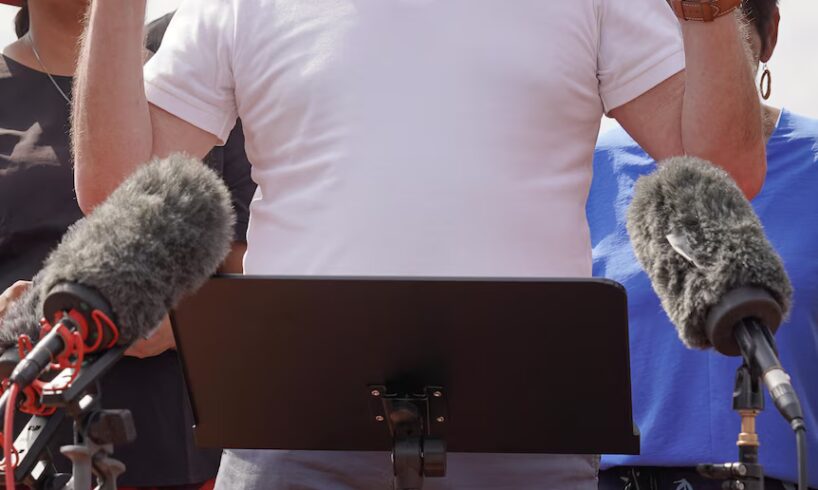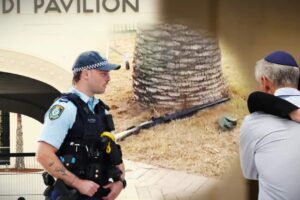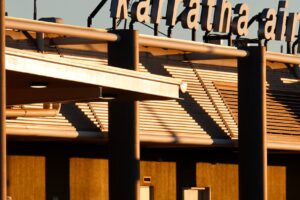
Wet weather could not dampen the outback spirit in Central Australia this weekend, as crowds gathered to celebrate the anniversary of a pivotal moment in the Aboriginal land rights movement.
Sunday marks 40 years since the government handed back Uluṟu-Kata Tjuṯa — the iconic red monolith and its surrounding national park — to traditional owners.
It was a powerful gesture acknowledging the World Heritage-listed site belonged to the Anangu, Pitjantjatjara and Yankunytjatjara people, who have deep cultural and spiritual ties to the land.
A number of Northern Territory politicians joined Anthony Albanese to celebrate the handback anniversary. (ABC News: Xavier Martin)
Prime Minister Anthony Albanese travelled to the Northern Territory’s Red Centre for the occasion, addressing the crowd on Saturday with a phrase in traditional Indigenous language.
“Ngayulu-na pukul-pa kuwari Anangu-ku mantangka tjunguringkula ngaranyi,” he said in a speech.
It means: “I am happy to be together [with you] on Anangu land”.
Mr Albanese said the anniversary stood “tall in the story of our nation”, as a “powerful moment” in land rights history.
The festivities included a sunrise viewing of Uluru and performances by Indigenous dancers and musicians. (ABC News: Xavier Martin)
“We look to Uluṟu and behold a physical presence that seems somehow vaster than time,” he said.
“Around the world, it is instantly recognised as Australian.
“In Australia, it stands as a monument to a people’s love of country and their determination to see justice done.
“It stands as firmly in our hearts as it does in the heart of our continent.”
People travelled to the Red Centre from all over to celebrate the Uluṟu-Kata Tjuṯa handback anniversary. (ABC News: Xavier Martin)
Reflecting on the past and future
In 1983, following years of First Nations lobbying, then-prime minister Bob Hawke announced the Aboriginal Land Rights Act would be amended to return Uluṟu-Kata Tjuṯa National Park to traditional owners.
The title deeds were officially handed back in October 1985.
Sammy Wilson, the grandson of a traditional owner involved in the site’s handback, said it was a hard-fought journey that spanned several decades.
He said the community worked with anthropologists “to prove” to government and the courts how significant the region was for First Nations families, with protests and lobbying forming part of the powerful land rights movement.
Sammy Wilson (centre), pictured alongside Craig Woods (left) and Malya Teamay (right), says years of lobbying preceded the handback. (ABC News: Xavier Martin)
“Now look where we are, 40 years later,” he said.
This weekend was the first time Mr Albanese had returned to Anangu land since the Voice to Parliament referendum was voted down by the public two years ago.
Unpacking what the Uluru Statement from the Heart means
“I’ve continued to do what we can to advance reconciliation, I put forward the referendum in the form that Indigenous people themselves asked for when they met here in 2017,” he said.
“Change is hard, but progress occurs — it doesn’t occur in a straight line, and it’s not easy.
“Hard things are worth doing.”
The prime minister said the anniversary was an opportunity to gather and “reflect on what has been achieved over the years” — like the successful 1967 referendum — and look to the road ahead.
Working together
Mr Albanese acknowledged the 99-year lease signed by the Anangu people in 1985, which agreed to joint management between traditional owners and the Commonwealth.
He said its anniversary served as a reminder that “as Australians, we are at our best together”.
Ricky Archer tries to ensure his work maintaining the site continues to align with the wishes of traditional owners. (ABC News: Xavier Martin)
National Parks Australia director Ricky Archer explained the handback had set a precedent, going on to influence how Australia valued traditional owners and their rights to looking after their country.
“We need to listen and learn,” he said.
“I think we can continue to build and strengthen that to get to a level that is, not just at standard, but is leading in the way country should be managed.”
Marking 40 years since Uluṟu-Kata Tjuṯa returned to Anangu
His co-worker Shaeleigh Swan was the first Anangu woman ever to manage the park, and her ability to translate traditional language helps the team work together.
“It’s an honour to be in this position, it’s been a great opportunity to reflect,” she said.
“I never thought I’d be the park manager, but I just wanted to make a difference.”
Shaeleigh Swan says it is an honour to help maintain the sacred site. (ABC News: Xavier Martin)
Joint management of the site has not always been smooth sailing, but Mr Wilson said working through problems together helped ensure it was maintained in a way everyone could be proud of.
Selena Kulitja is part of an Anangu group that recently travelled to London and met with King Charles to mark the anniversary.
She said future generations would continue the tradition of caring for the land, as they learned to “take over the place, to carry our country”.
The sacred site brought her a sense of joy and pride, she said, and the celebration helped highlight the stories, culture and knowledge tied to Uluṟu-Kata Tjuṯa National Park.
Selena Kulitja says future generations will continue to learn how to care for country. (ABC News: Xavier Martin)
‘The world is welcome here’
The prime minister reflected on the generosity of the traditional owners, who responded to the handback “by choosing to share it with all of us”.
“Forty years ago, after decades of exclusion, the Anangu’s rightful relationship with this place was finally recognised,” Mr Albanese said.
He described the iconic red landmark as “vast and immovable”, but said it moved people in ways that could not always be explained.
“All Australians are welcome here — the whole world is welcome here,” the prime minister said.
“There is room for all of us.”
Pitjantjatjara and Yankunytjatjara woman Alison Carroll, who was there for the 1985 handback, said it was “very important” to remember that moment in the land rights movement.
Alison Carroll is happy to welcome people from all over the world to her people’s sacred site. (ABC News: Xavier Martin)
“It’s for everybody, to come here and to see this rock and be happy,” she said.
“People love to come here.”
She said this weekend’s anniversary was a great opportunity for travellers to witness the landmark and learn the “sacred stories” that surrounded it.
Mr Albanese said he was deeply honoured to be the first prime minister to attend a handback anniversary celebration, and expressed his gratitude to the Anangu people.
“We thank you for your patience, we thank you for your grace, and we draw together in happiness,” he said.
This time of year, the NT is transitioning from dry season to wet season. (ABC News: Xavier Martin)





